Manipuri Textile from Bangladesh and Myanmar
- Art of Textile -
- Part 3-
By: Mutua Bahadur *
Bangladesh
Bangladesh is one of the South-Eastern Asian countries encircled by Indian states of Meghalaya, West Bengal. Tripura and Assam. Myanmar is to the east of India and the Bay of Bengal in the south is the only external outlets other than the Indian states. The earliest settlement of Manipuris in Bangladesh dates back to the reign of Maharaja Garibaniwaj (1709-1748).
Here, Manipuris mean Meiteis only. Manipuri Muslims also settled in Bangladesh and they are known as Meitei Pangal. During the period of Maharaja Marjit in 1819, Maha Bandula of Myanmar invaded Manipur and the princes of Manipur fled their homeland for safety. Myanmar conquered Manipur and the period between 1819-1826 is known as Seven Years Devastation in history.
Gambhir Singh left Sylhet (Bangladesh) on 1st May 1825, and raised 500 Manipur Levy to regain the lost independence of Manipur. Marjit remained at Mouluvibazar of Bhanugach. Bangladesh, till his last day. Now, the place has come to be known as Konung Leikai (Manipuri Rajbari). Gambhir Singh established his palace in an area of sixty acres situated at Mirja forest of Sylhet district. Now, the place is also known as Konung Leikai (Manipuri Rajbari). The palace has a storied gate, a private house and the area is encircled by seven brick walls.
Temples for Pakhangba, Yumjao Lairembi and the Lainingthou Nongsaba were also there inside the palace. Two ponds were also dug for the king and the queen's use only. Though the Manipuris' earliest settlement in Bangladesh dates back to the period of Jaishree Maharaja Garibaniwaj, it was during the Seven Years Devastation that they began settling in Bangladesh normally on a large scale.
Manipuris also settled in Dhaka, the present capital of Bangladesh. However, there are two different views on this regard. One is that in 1661, one Mughal subedar, Mir Yamuna, brought some Manipuri soldiers as captives while on his returning journey to Dhaka after conquering Assam. Those Manipuri captive soldiers were settled around this place.
After that the place was known as 'Manipuri para'. The other view was that in 1840, some Manipuri princes with their trusted soldiers, fled from their palace due to a fierce fight that took place between Myanmarese and the Manipuris, and settled at Dhaka. After that the place, where the Manipuris settled, becomes known as 'Manipuri para'. During the reign of Chandrakriti Maharaja of Manipur, Devendra Maharaja was expelled from Manipur (Devendra reigned as a king of Manipur for only three months in 1850).
Chandrakriti Maharaja, with the help of the British army, captured Devendra with some of his soldiers and moved to Nodia firstly, then Murshidabad and finally Dhaka. Devendra and his followers settled at a place in Dhaka and later the place comes to be known as 'Manipuri para'. The Cheitharol Kumbaba, the Royal Chronicle of Manipur, mentions that Meidingu Nunglen Khomba (Devendra) fled to Mayang leibak after losing a fierce battle of three nights in the month of Inga (June-July). 1850.
Devendra, owing to his settlement at Dhaka, became known as 'Dhaka-taba' and remained at Bangladesh till his death. Many temples, houses and ponds were developed. Many princes and Brahmins also settled there. Ratnamanjuri, Devendra's daughter married King Kishwar Manikya of Tripura(1896-1909).
Places where Manipuris settled
The Manipuris scattered into four districts of Bangladesh. They are Sylhet district. Mouluvibazar district, Shunamgonj district and Habigonj district. In early times, Manipuris also settled at Dhaka. Mymensingh and Comilla.
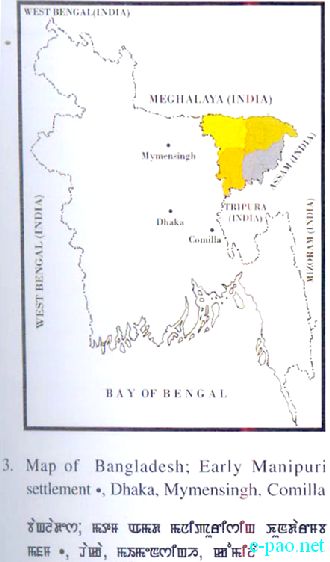
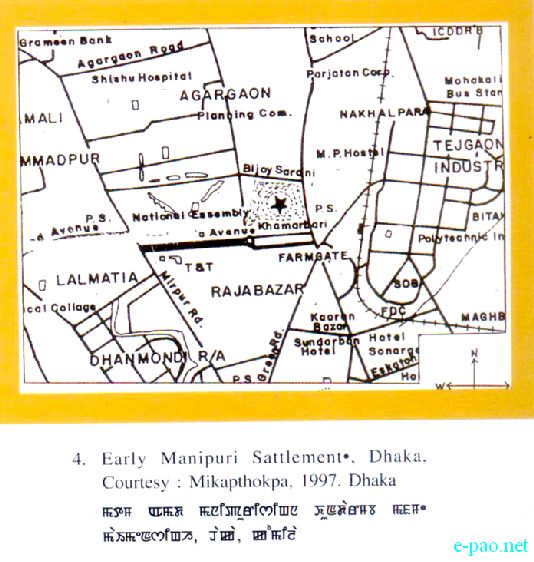
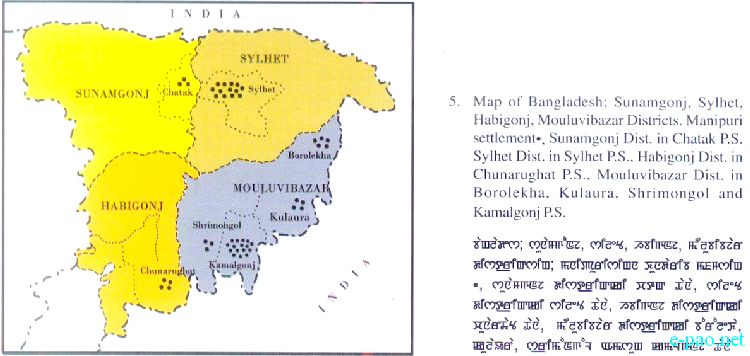
There are thirteen villages in Sylhet district. They are
- Amborkhana (Nongthombam Leikai in Manipuri),
- Nayabazar,
- Shibgonj,
- Goaipara,
- Kewapara,
- Sagordighirpar (Pukhri Mapan in Manipuri),
- Baghbari,
- Laladighipar (Sapam Leikai in Manipuri),
- Lamabazar (Leichom Leikai in Manipuri).
- Doxingach,
- Rajbari (Konung Leikai in Manipuri),
- Brojonath tila (Manipuris call it as Brajanath Leikai but earlier it was known as Narasingh tila)
- Noyabazar (Sylhet P.S.),
In Mouluvibazar district, Manipuris have settled in twenty-eight villages. They are -
- Photiguli,
- Goalbari,
- Naldhari.
- Boroiloli (Kulaura P.S.),
- Ramnagar,
- Khaspur,
- Balishira (Shrimongol P.S.),
- Gouranagar,
- Puthadhor,
- Chotodhamai.
- Patharia.
- Gourangabil (Borolekha P.S.),
- Madhobpur.
- Chaiciri (Nongthombam Leikai in Manipuri).
- Homerjan,
- Majhergaon.
- Shangaon (Hamom Khul in Manipuri),
- Haqtiarkhola.
- Shripiire,
- Bhandarigaon.
- Chitlia,
- Noyapattan.
- Ganganagar,
- Bhanubil,
- Katabil
- Tateygaon (Mange Makhong Khul in Manipuri),
- Mongolpur (Haobam Leikai in Manipuri)
- Konagoan (Kamalgonj P.S.)
- Gaborkhula,
- Abadgaon,
- Shibnagar and
- Dudhpatil.
- Nayanpur.
- Lakhat and
- Ratanpur.
In 1930 there were around twenty Manipuri houses in Manipuri para. It is believed that the reason, behind the Manipuris fleeing Dhaka, was the fierce communal clashes that took place between the Hindus and the Muslims. Some of them migrated to Tripura (India) and some to Sylhel district. Bangladesh. There were Manipuri villages till 1938 at Mymensing. Some Manipuris from Tripura came to Comilla district and settled there. There were Manipuri settlements at Akhoura.
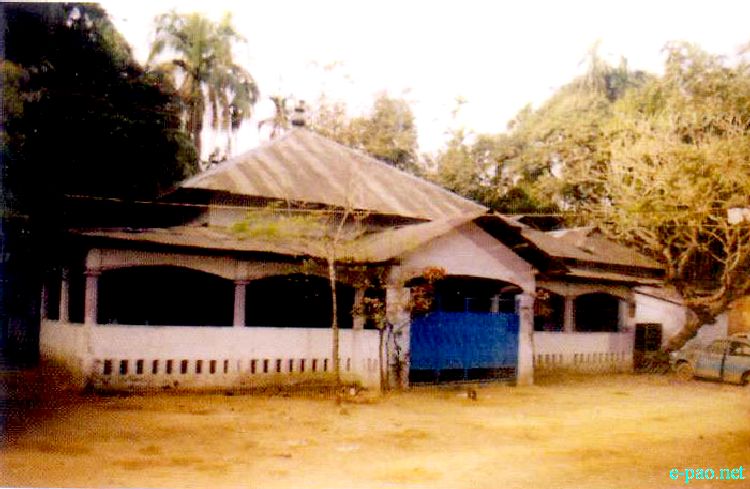
Residential and temple architecture
Those Manipuris settled in Bangladesh adopted Gouriya Vaisnavites. There were some who followed Poirei Apokpa and Apokpa. Most of the Manipuri Hindu temples are constructed with wood, mud C.I. sheet. And some of the temples are of brick and C.I. sheet. Most of the temples face eastwards and southwards. The roofs of the temples are pyramidal.
Generally. mandhavs facing temples arc constructed with wood and covered with C.I. sheets. Mandhavs arc used for religious and other purposes. At some other places temples are raised with bricks, wood and the roof is of C.I. sheets. Some of the temples of Poirei Apokpa and Apokpa arc of bricks and they are placed around courtyards and no mandhav is there. And some of the temples for Poirei Apokpa are highlighted with aluminum sheets displaying seven layers of shekpin (storied decoration), and a picture of Pakhangba tuthup on a flag at the top. This flag has a red filled circle at the centre and it is fastened to an iron rod.
Bricks were used for some of the umang lai (deity) temples; at some other places wood, mud and C.I. sheets were the main materials for contrusction. A rectangular flag stretched with split bamboo, numbering 3 or 5, is placed near an umang lai temple.
Most of the houses of the Manipuris who settled in villages had wooden poles, plastered mud wall for the main frame and C.I. sheets for the roof. And some of houses had brick walls, with the upper part being in wood and C.I. sheets.
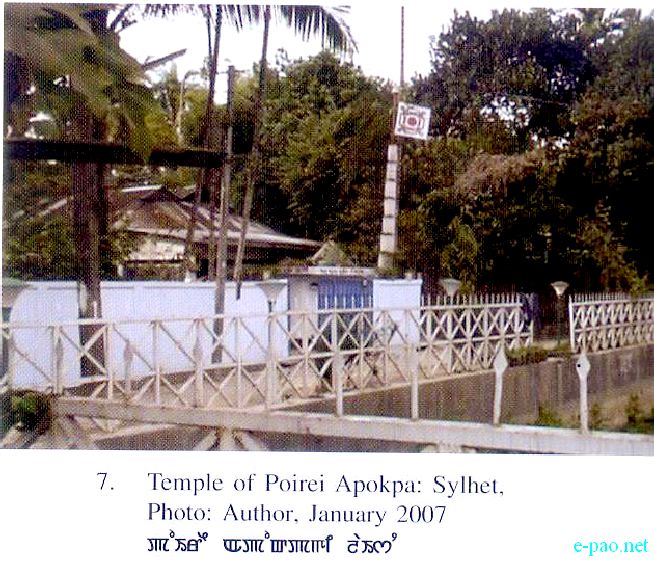
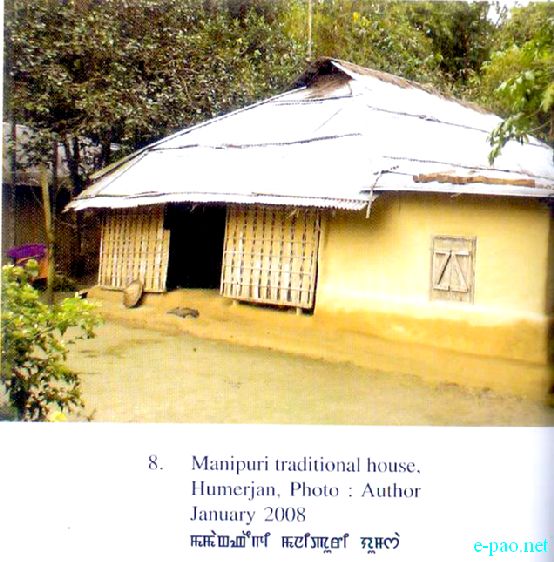
Generally, Manipuri houses face the eastern direction. And some of the Meitei yumjao (traditional Meitei house) had C.I. sheet roof after removing the thatch. There may he extension of rooms due to overcrowded conditions in the family. At some places of Mouluvibazar district, there were some thatched Meitei yumjaos till 1981.
Some houses of Mouluvibazar had awang sanggoi (northern out- house), makha sanggoi (southern outhouse) and mamang sanggoi (eastern outhouse). Generally, there is a tulsi pung (a sacred spot where tulsi basil, is planted) before the house. These sanggois (out-houses) are used for weaving purposes, and keeping other implements for agricultural purposes. Bamboo fences are between adjoining courtyards. Kwa (betel nut) plants are planted
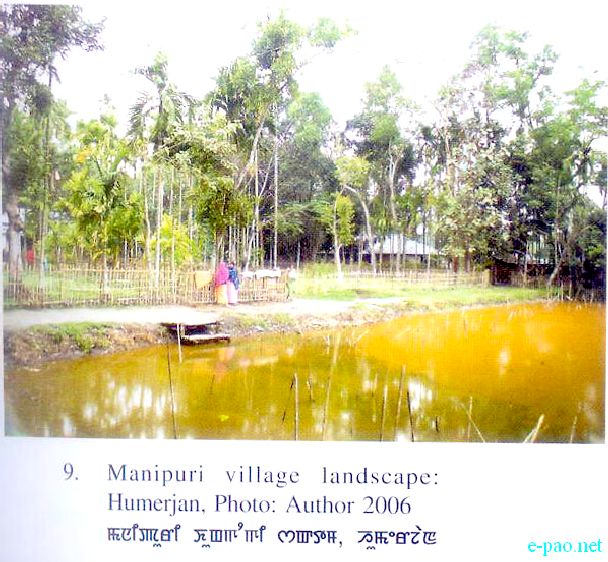
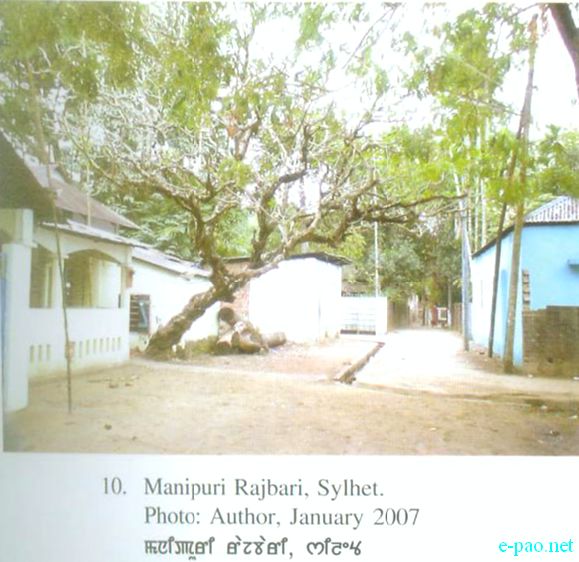
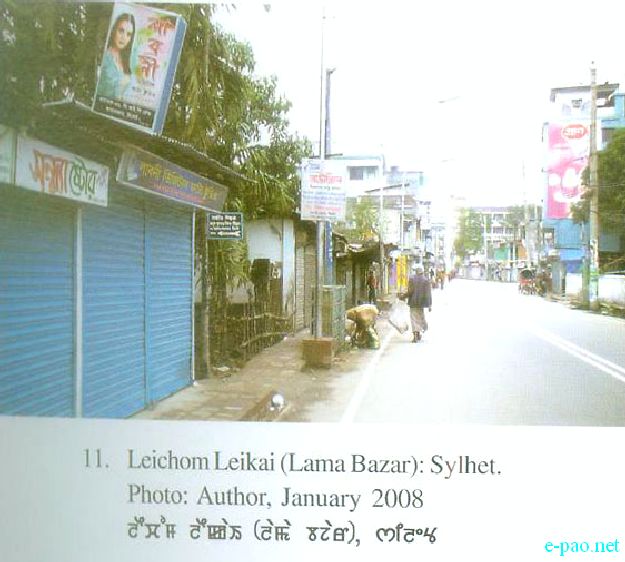
around the boundary to serve as fences and boundary marks. There is a gate for each family. Very rarely, some village households used to have bamboo-gates which had holes on the vertical supports and smaller bamboo poles are pulled through them. Manipuris have been included among the upajati (minority) communities since 1975-76 and there has been no change till date. There is a strong belief in the minds of Manipuri elders that one day they will return to their motherland, Manipur (India), as they think of their
stay as temporary exile.
So, they sold their best belongings and left suitable places. In their psychy they have the belief that they have been there due to the Seven Years Devastation (1819-1826). From 1981 onwards Manipuris seriously began discussing about not leaving Bangladesh. Many Manipuris sacrificed their lives and became saheeds (patriots) during the Independence movement of Bangladesh (Partition of Bangladesh from Pakistan).
See a gallery photo of this Textile here.
To be continued ....
|
* Mutua Bahadur contributes to e-pao.net regularly. This article was webcasted on August 27, 2010.
* Comments posted by users in this discussion thread and other parts of this site are opinions of the individuals posting them (whose user ID is displayed alongside) and not the views of e-pao.net. We strongly recommend that users exercise responsibility, sensitivity and caution over language while writing your opinions which will be seen and read by other users. Please read a complete Guideline on using comments on this website.









